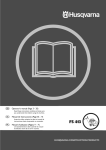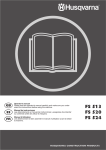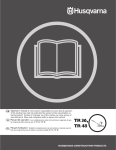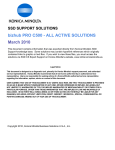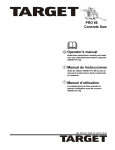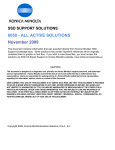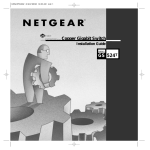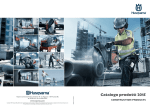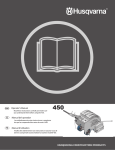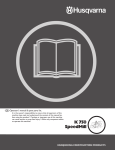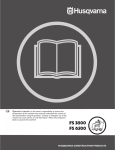Download Husqvarna FS 524 Chainsaw User Manual
Transcript
Operator’s manual Read these instructions carefully and make sure you understand them before using the machine. Manual del operador Lea cuidadosamente estas instrucciones y asegúrese de que las comprende bien antes de usar el FS 4800. Manuel d’utilisation ��������� Veuillez lire ������������������������������������������������������� attentivement ces instructions et assurez-vous de bien les comprendre avant d’utiliser la machine modèle FS 4800. FS 513, FS 520, FS 524 CONTENTS and INTRODUCTION Contents Section Page Contents & Introduction................................................ 3 WARNING! Symbols and Decals....................................................4-8 Before operating machine, read and understand this entire operation manual & engine operation manual supplied with engine. Safety Instructions.....................................................9-12 Be familiar with machine before operation! Parts Identification (What Is What).........................14-16 Assembly................................................................. 17-21 Model Identification: Record machine serial number plate information below for future reference Operation ................................................................ 22-27 Maintenance & Lubrication ................................... 28-32 Trouble Shooting Guide............................................... 33 Wiring diagram........................................................ 34-38 Technical Data......................................................... 39-40 Accessories.................................................................. 41 Conformity Certificates.................................................42 Contact Information.......................................................43 Introduction Thank you for purchasing your new machine from Husqvarna Construction Products. We have provided important safety messages in this manual and on the machine. Please read these messages carefully. A safety message alerts you to potential hazards that could hurt you or others. Each safety message is preceded by a symbol or the safety alert symbol ( ) and one of two words, WARNING, or CAUTION. These signal words mean: WARNING: Indicates a hazardous situation which, if not avoided COULD result in death or serious injury. CAUTION: Indicates a hazardous situation, which, if not avoided, COULD result in minor or moderate injury. It may also be used to alert against unsafe practices. Each message tells you what the hazard is, what can happen, and what you can do to avoid or reduce injury. Other important messages are preceded by the word NOTICE. NOTICE means: NOTICE: Indicates a hazardous situation which, if not avoided, could result in property damage. Your machine or other property can be damaged if you don’t follow this instruction. The safety labels should be periodically inspected and cleaned by the user to maintain good legibility at a safe viewing distance. If the label is worn, damaged, or is illegible, it should be replaced. A. Model:______________________________________ B. Machine Serial No:____________________________ C. Year of Manufacture ___________________________ D. Mass of Machine (kg) __________________________ E. Engine Power (KW) ___________________________ F. Blade Diameter (mm) __________________________ G. Blade Speed (Revolutions / Minute) _______________ H. Electric Motor Voltage (If Equipped) _______________ I. Electric Motor Phase (If Equipped) _________________ J. Electric Motor Amperage (if Equipped) _____________ Other information not shown on machine serial plate: Engine Serial No: _______________________________ See Engine Operation Manual for location. Purchase Date:_________________________________ SYMBOLS and DECALS Please read the instructions for use prior to operating the machine for the first time. Emergency Shutdown, Transmission Stop Use In Well Ventilated Area This symbol indicates that the machine is in conformance with the applicable European directive. Mandatory Do Not Use In Flammable Areas Machinery Hazard, Keep hands and Feet Clear. Indication Muffler Hot. May Cause Burns and / or Ignition of Material. Avoid Contact. Prohibition Danger, Poison Exhaust Gas Warning Triangle No Non-working Personnel In Area Wear Eye Protection No Smoking Wear Breathing Protection The use of hearing protection is mandatory Wear Head Protection Wear Safety Shoes Wear Appropriate Clothing Remove the blade prior to Hoisting, Loading, Unloading and Transporting the Machine. Do Not Operate Without Blade Guard in Place Always Keep All Guards In Place Water Supply On Water Supply Off Water Supply SYMBOLS and DECALS Blade Water Safety Switch Electrical Switch-Start Engine Coolant Temperature Repairs Are To Be Done By An Authorized Dealer Only Keep Work Area Clean/Well Lit, Remove All Safety Hazards Headlight Dangerously High Noise Level Diamond Blade Pay Extreme Attention to The Care And Protection Of The Machine Before Starting Up Blade Diameter Remove Tools From Area and Machine Engine Oil Pressure Blade Engagement Pulley diameter Oil Required Number of Revolutions Per Minute, Rotational Speed Dipstick, Maintain Proper Oil Level Blade Flange Diameter Lubrication Point Blade Depth Stop High Speed Cutting Depth Indicator – Depth of Cut Low Speed Parking Brake Electrical Switch-Off Parking Brake Applied Electrical Switch-On Parking Brake Released SYMBOLS and DECALS Machine Mass (Kilograms) Engine Stop Positive Battery Terminal Engine Start Blade Depth Indicator – Zero Engine Run Electric Motor Engine Engine Speed Revolutions/Minute Engine Start Unleaded Fuel Only Disengage to Start Engine (Neutral Start) Stop Engine and Engage Transmission to Engage Parking Brake SYMBOLS and DECALS P/N 542 19 07-08 (2) Location: Left and Right Side of Cowl (FS 513 Only) P/N 542 19 07-33 Location: Front of Cowl P/N 542 19 07-09 (2) Location: Left and Right Side of Cowl (FS 520 Only) P/N 543 85 00-37 “Blade Guard Arrow (FS 524 - 600mm Only) Top of Rear Blade Guard (600 mm FS 520-FS 524 Only) P/N 542 19 07-10 (2) Location: Left and Right Side of Cowl (FS 524 Only) P/N 542 16 72-98 (2x) Location: Left and Right Side of Blade Guard (FS 513, 520 Only) P/N 542 19 06-46 Local Service Location: Side of Frame P/N 542 19 05-89 Location: Depth Gauge SYMBOLS and DECALS P/N 542 16 90-65 Location: Top of Belt Guard P/N 542 19 05-93 Location: Rear of Cowl P/N 542 19 06-36 Location: Top of Cowl, FS 520, FS 524 P/N 542 19 06-17 Location: Water Tank (If Equipped) P/N 502 24 01-01 Location: Top of Cowl, FS 513 P/N 542 19 06-38 Location: Rear of Cowl P/N 543 04 57-88 SOUND LEVEL - 108dBA Location: Upper RH Frame P/N 542 16 12-35 PATENT PENDING Location: Upper RH Frame SAFETY INSTRUCTIONS Fuel Safety: General use WARNING! Take care when handling fuel. Bear in mind the risk of fire, explosion and inhaling fumes. WARNING! Before operating machine, read and understand this entire operation manual & engine operation manual supplied with engine. Be familiar with machine before operation! Operator must wear personal protective equipment & clothing appropriate to the work he is doing. Personal protective equipment, such as hearing & eye protection, is mandatory. The working area must be completely clear, well lit and all safety hazards removed. Any persons not involved in the work, should leave the area. WARNING! Do not contact the tool when machine is in operation. • Only store fuel in containers approved for the purpose. • Only refuel machine with engine OFF. Never remove fuel cap and fill the fuel tank while the engine is running. • Always refuel in a well ventilated area. • Never fill a fuel tank indoors. • Allow engine to cool before refueling. Never fuel machine in vicinity of sparks or flames. Do not use machine in flammable area. Do not smoke while fueling or using the machine. • Move machine 10 feet (3 meters) from refueling point before starting engine. • Never start the machine: 1) If fuel has been spilled on the machine. Wipe off spillage and allow remaining fuel to evaporate. 2) If you have spilled fuel on yourself or your clothes. Use soap and water to wash any part of your body that has come in contact with fuel. 3) If the machine is leaking fuel. Check regularly for leaks from the fuel cap and fuel lines. • Store and transport machine and fuel so that there is no risk of any leakage or fumes coming into contact with sparks or flames, for example, electrical machinery or electric motors, electrical relays / switches, or boilers. DUST WARNING Cutting, especially when DRY cutting, generates dust that comes from the material being cut, which frequently contains silica. Silica is a basic component of sand, quartz, brick clay, granite and numerous other minerals and rocks. Exposure to excessive amount of such dust can cause: • • • Respiratory diseases (affecting your ability to breath), including chronic bronchitis, silicosis and pulmonary fibrosis from exposure to silica. These diseases may be fatal; Skin irritation and rash; and Cancer according to NTP* and IARC* * National Toxicology Program, International Agency for Research on Cancer Take precautionary steps • • • Avoid inhalation of and skin contact with dust, mist and fumes; Wet cut when feasible, to minimize dust; Wear and ensure that all bystanders wear appropriate respiratory protection such as dust masks designed to filter out microscopic particles. (See OSHA 29 CFR Part 1910.1200) California Prop 65 Warning: Use of this product can cause exposure to materials known to the State of California to cause cancer and/or birth defects or other reproductive harm. SAFETY INSTRUCTIONS WARNING POISON EXHAUST GAS THIS SAW IS SHIPPED FROM THE FACTORY WITHOUT A CATALYTIC CONVERTER. THE ENGINE PRODUCES CARBON MONOXIDE EXHAUST EMISSIONS AND IS NOT SAFE FOR USE IN ENCLOSED AREAS. USE OF A CATALYTIC CONVERTER REDUCES THE CARBON MONOXIDE EXHAUST EMISSIONS, BUT STILL IS NOT SAFE FOR USE IN ENCLOSED AREAS. USE ONLY IN WELL-VENTILATED AREAS. WORK SITE AIR QUALITY MUST COMPLY WITH OSHA 29 CFR 1910.1000 PER TABLE Z-1, LIMITS FOR AIR CONTAMINANTS. MONITOR WORKSPACE AIR QUALITY TO INSURE COMPLIANCE. FAILURE TO COMPLY WILL RESULT IN DANGER TO LIFE AND CAUSE PERMANENT INJURY OR DEATH. General Information Carbon monoxide (CO) has the distinction of being one of the few commonly encountered industrial gasses that is both highly toxic (poison) and odorless. When inhaled, CO acts as a chemical asphyxiant by preferentially combining with hemoglobin in the blood stream. As a result, the hemoglobin is not able to transport its normal amount of oxygen, which results in under-oxygenation of tissues. Symptoms of low-level CO exposure include headaches, dizziness, confusion, and nausea. However, loss of consciousness, permanent injury and death may result from continued or more intense exposure. Because of the health hazards associated with CO inhalation, the Occupational Safety and Health Administration (OSHA) have imposed personal exposure limits. The OSHA exposure limits, which are specified in the 29 CFR 1910.1000 (1998 Revision), allow for a 200 PPM Ceiling Limit and a TWA of 35 PPM per 8-hour shift/40-hr workweek. It is strongly recommended that the OSHA 29 CFR 1910.1000 (Code of Federal Regulations) be consulted for more information on exposure limits for various hazardous materials. If CO Poisoning is suspected immediately remove the victim to fresh air and obtain emergency medical attention. Proper Ventilation: THIS SAW IS SHIPPED FROM THE FACTORY WITHOUT A CATALYTIC CONVERTER. It is important to be aware that saws with catalytic converters reduce CO and hydrocarbon (HC) emissions. The exhaust still contains CO. If the workspace is too confined or under-ventilated, CO may accumulate until it eventually exceeds OSHA limits. When this happens, action must be taken to remove workers from areas of high concentration. Operators and work area supervisors should take precautions to insure adequate ventilation of the workspace at all times. Carbon monoxide detection monitors should be used to determine that adequate ventilation exists. WARNING HEARING HAZARD DURING NORMAL USE OF THIS MACHINE, OPERATOR MAY BE EXPOSED TO A NOISE LEVEL EQUAL TO 85 dB (A) OR GREATER. TEMPORARY AND/OR PERMANENT DAMAGE TO HEARING MAY RESULT. HEARING PROTECTION REQUIRED. 10 SAFETY INSTRUCTIONS SAFETY FIRST! WARNINGS DO’s AND DO NOT’s WARNING: FAILURE TO COMPLY WITH THESE WARNINGS AND OPERATING INSTRUCTIONS COULD RESULT IN DEATH OR SERIOUS BODILY INJURY. DO DO Read this entire operator’s manual before operating this machine. Read and understand all warnings, instructions, controls, and symbol definitions contained in this manual, and on the machine. DO always give a copy of this manual to the equipment user. If you need extra copies, call TOLL FREE 1‑800‑288-5040 in USA, or +1-913-928-1300 for International, or see “contact information” section of this manual. DO keep all guards in place and in good condition. DO wear safety approved hearing, eye, head and respiratory protection. DO read and understand all warnings and instructions on the machine. DO keep all parts of your body away from the blade and all other moving parts. DO know how to stop the machine quickly in case of emergency. DO shut off the engine and allow it to cool before refueling or doing maintenance. DO inspect the blade, flanges and shafts for damage before installing the blade. DO use the blade flange size shown for each blade size. DO use only steel center diamond blades manufactured for use on concrete saws. DO use only the blade flanges supplied with the saw. Never use damaged or worn blade flanges. DO use only blades marked with a maximum operating speed greater than the blade shaft speed. Verify speed by checking blade shaft rpm and pulley diameters and blade flange diameters. DO verify saw drive configuration by checking blade shaft RPM, pulley diameters, and blade flange diameter. DO read all safety materials and instructions that accompany any blade used with this machine. DO inspect each blade carefully before using it. If there are any signs of damage or unusual wear, DO NOT USE THE BLADE. DO mount the blade solidly and firmly, Wrench tighten the arbor nut. DO make sure the blade and flanges are clean and free of dirt and debris before mounting the blade on the saw. DO use the correct blade for the type of work being done. Check with blade manufacturer if you do not know if blade is correct. DO use caution and follow the instructions when loading and unloading the machine. DO operate this machine only in well ventilated areas. Breathing Poison Exhaust Gas could result in death. DO instruct bystanders on where to stand while the machine is in operation. DO establish a training program for all operators of this machine. DO clear the work area of unnecessary people. Never allow anyone to stand in front of or behind the blade while the engine is running. DO make sure the blade is not contacting anything before starting the engine. DO use caution when lifting and transporting this machine. DO always tie down the machine when transporting. DO use caution and follow instructions when setting up or transporting the machine. DO have all service performed by competent service personnel DO verify the blade arbor hole matches the machine spindle before mounting the blade. DO always check for buried hazards, such as electrical or gas lines before sawing. Always contact local utilities before operation in unknown areas. DO move the machine at least 10 feet (3 meters) from the fueling point before starting the engine and make sure the fuel cap is on the machine and properly tightened. DO lift machine only from specified lifting point. DO clean the machine after each day’s use. DO use the proper blade flange size for each blade size. Never use damaged or worn blade flanges. DO use caution when handling fuel. DO only cut in a straight line, and only saw as deep as the job specifications require. 11 SAFETY INSTRUCTIONS SAFETY FIRST! WARNINGS DO’s AND DO NOT’s WARNING: FAILURE TO COMPLY WITH THESE WARNINGS AND OPERATING INSTRUCTIONS COULD RESULT IN DEATH OR SERIOUS BODILY INJURY. DO NOT DO NOT DO NOT DO NOT DO NOT DO NOT DO NOT DO NOT DO NOT operate this machine unless you have read and understood this operator’s manual. operate this machine without the blade guard, or other protective guards in place. stand behind or in front of the blade path while the engine is running. leave this machine unattended while the engine is running. work on this machine while the engine is running. operate this machine when you are tired, fatigued or under the influence of drugs or alcohol. use a wet blade without adequate water supply to the blade. exceed maximum blade speed shown for each blade size. Excessive speed could result in blade breakage. DO NOT operate the machine if you are uncertain of how to run the machine. DO NOT use damaged equipment or blades. DO NOT touch or try to stop a moving blade with your hand. DO NOT cock, jam, wedge or twist the blade in a cut. DO NOT transport a cutting machine with the blade mounted on the machine. DO NOT use a blade that has been dropped or damaged. DO NOT use carbide tipped blades. DO NOT touch a dry cutting diamond blade immediately after use. These blades require several minutes to cool after each cut. DO NOT use damaged or worn blade flanges. DO NOT allow other persons to be near the machine when starting, refueling, or when the machine is in operation. DO NOT operate this machine in an enclosed area. Breathing Poison Exhaust Gas could result in death. DO NOT operate this machine in the vicinity of anything that is flammable. Sparks could cause a fire or an explosion. DO NOT allow blade exposure from the guard to be more than 180 degrees. DO NOT operate this machine with the belt guards or blade guard removed. DO NOT operate this machine unless you are specifically trained for its operation. DO NOT use a blade that has been over heated (Core has a bluish color). DO NOT jam material into the blade. DO NOT grind on the side of the blade. DO NOT tow this machine behind a vehicle. DO NOT operate this machine with the any guards or shields removed. DO NOT cut deeper than 1” per pass with a dry blade. Step cut to achieve deeper cuts. DO NOT operate this machine while under the influence of drugs or alcohol. ***************** This saw was designed for certain applications only. DO NOT modify this saw or use for any application other than for which it was designed. If you have any questions relative to its application, DO NOT use the saw until you have written Husqvarna Construction Products and we have advised you. Husqvarna Construction Products North America 17400 West 119th Street, Olathe, Kansas 66061 USA 12 NOTES 13 PARTS IDENTIFICATION (WHAT IS WHAT) A. Front Pointer: Use to Guide machine in a straight line. O. Lifting Point: Lift machine only from this point! B. Guide Wheel: On Front Pointer (A). Align to cutting line and Blade (H) to produce straight cuts. P. Water Tank (If Equipped): 25 Liter (6.6 U.S. Gallon) water capacity. Fill only with water! Do not fill with gasoline or other flammable substances! Use only for dust suppression when cutting dry. Use only with laser welded (dry) Diamond Blades (H). C. Blade Guard: Covers Blade (H). Must always be in place when operating machine! Note tool direction as marked on guard with an arrow. D. Blade Guard Front: Part of Blade Guard. Can be raised to install Blade (H). E. Blade Guard Rear Bolt: Holds Blade Guard (C) in position. Must be removed and relocated if Blade Guard (C) is moved. F. Blade Guard Latch Plate: Covers Outer Flange (J). G. Water Hose Disconnect (G): Connects Blade Guard (C) to Water Control Valve (KK1, KK2) or Water Tank (P). Can be used when Blade Guard (C) is mounted to left or right side of machine H. Blade: Tool that cuts asphalt or concrete material – not included with machine. I. Inner Flange: Arbor on which the Blade (H) is mounted. Replace if Damaged or worn. J. Outer Flange: Used to hold Blade (H) in position. Contains Locking Pin (K) that must go through Blade (H). Replace if damaged or worn. K. Locking Pin: Holds Blade (H) in position. Replace if Damaged or worn. L. Blade Shaft Nut (L1 / L2): Holds Outer Flange (J) to machine. Nut (L1) on right side of machine has Left Hand threads. Nut (L2)(not shown) on left side of machine has Right Hand threads. Q. Engine Starting Rope (FS 513 Only): Use to start engine. See engine operation manual. R. Fuel Tank: Fuel fill point. FS 520 / FS 524: Located at rear of machine. Fuel fill is located on Left hand side of fuel tank. FS 513: Located on engine - See engine operation manual. S. Engine Air Cleaner (FS 513 Shown): Check daily. Clean every four (4) hours if cutting in dusty conditions. See engine operation manual and maintenance section of this document. T. Blade Shaft Wrench (27mm): Use for installing and removing Blade (H). Store in Tool Compartment (BB). U. Wrench (13mm): Use for many maintenance items on machine. Store in Tool Compartment (BB). V. Front Cover: Clips to Water Tank Support (N). Open to turn Engine Start Switch (DD) ON (1) or OFF (0) [FS 513 Only]. W. Shaft Guard: Protects Inner Flange (I). Always installed on opposite side of frame to Blade Guard (C). X. Depth Control Grease Fitting: Not Shown. See Maintenance section of this document. M. Blade Arbor: Blade (H) mounts on this surface. Y. Blade Guard Mounting Spade: Holds Blade Guard (C) in position. N. Water Tank / Lifting Point Support: Holds Water Tank (P). Supports Lifting Point (O). Z. Engine Oil Dipstick: Use to check engine oil level (Not Shown – See Operation Section of this document). 14 PARTS IDENTIFICATION (WHAT IS WHAT) AA. Emergency Stop Switch: Depress Switch to STOP engine in emergencies. Reset by pulling outward (pull up) to allow re-starting of machine. BB. Tool Compartment: Contains Operation Manual, Parts List, & two wrenches (T & U) (13mm & 27mm). Open by turning knob 180 degrees. Always return Operation Manual to this area for future reference. CC. Engine Throttle: Controls Engine speed (RPM). Push forward to increase engine speed. Pull backwards to decrease engine speed. All sawing is done at maximum engine speed. DD. Engine Start Switch: FS 513: Located on engine, behind Front Cover (V). Must be ON (1) to start engine. Use to turn engine OFF (“0”) in non-emergency situations. FS 520 & FS 524 (Electric Start): A key switch located on lower left side of console. Turn key clockwise to start engine. EE. Blade Depth Control: Turn Counter-Clockwise to raise Diamond Blade (H) and Clockwise to lower Diamond Blade (H). FF. Blade Depth Stop: To Lock Blade Depth Control (EE) in position. Pull Blade Depth Stop toward rear of machine and turn 90 degrees to lock in open position. GG. Blade Depth Indicator: Shows cutting depth of Diamond Blade (H) in centimeters (orange color) and inches (white color). Operation: With engine OFF (“0”), lower Diamond Blade (H) until in contacts the cutting surface. Rotate Blade Depth Indicator to align “0” with arrows. Raise Saw. When saw is lowered into cut, current cutting depth is shown. HH. Engine Tachometer (RPM): Shows engine speed in revolutions per minute if engine is running. Shows total operation time when engine is OFF (“0”). Total operation time shown in minutes from 0-59 minutes, and hours for 60+ minutes. II. – – – JJ. Rear Handle: Operator position is behind machine with both hands on Rear Handle. Handle is adjustable to several positions. KK1. Water Control Valve: Controls water flow to blade. Located on Left side of machine, near Rear Handle (JJ). Not used with the water tank (if equipped). KK2. Blade Guard Water Control Valve: Controls the water flow to the blade. Located on blade guard. Used with water tank (if equipped). LL. Belt Guard (Not Shown): Covers engine drive belt. MM. Belt Drive Idler: Used to hold tension on Blade Shaft Drive Belt. NN. Oil Drain Hose: Use to remove oil from engine. OO. Parking Brake (EU units): Used to hold machine in parked position. With engine OFF (0), apply the brake by moving Transmission Engagement Lever (PP), to the “Engaged” position. Move lever to dis-engaged position before starting engine! PP. Transmission Engagement Lever: MUST BE in rear (dis-engaged) position to start engine for FS 520 and FS 524 (Neutral Start function). Push forward to engage transmission. Push rearward to dis-engage transmission. With transmission dis-engaged, machine can be moved with engine turned OFF (0). See “OO. Parking Brake” for additional information. 15 PARTS IDENTIFICATION (WHAT IS WHAT) QQ. Travel Speed Lever: Controls ground travel speed and direction of machine (forward or reverse). Move lever forward to travel forward. Move lever rearward to travel backward. Lever MUST be near “STOP” position before moving Transmission Engagement Lever (PP) into “Engaged” position. UU. Transmission Drive Tensioner Belt: Connects Engine to Transmission Drive Belt Tensioner (VV). Check periodically for wear on belt and sheaves. RR. Starting Battery (FS 520, FS 524 Only): Located behind lower access panel at the rear of machine. See “Battery Maintenance” section of this document for instructions on charging and maintenance. WW. Hydrostatic Transmission Belt: Drives Hydrostatic Transmission (TT). Connects Transmission Drive Belt Tensioner (VV) to Hydrostatic Transmission (TT). See maintenance section of this document for more information. SS. Fuel Shut-Off Valve: Used to shut off fuel supply to engine. FS 520 / FS 524: Located behind lower access door at rear of machine. Turn counter-clockwise to close. FS 513: Located on engine (see engine operation manual for more information). TT. Hydrostatic Transmission: Controls travel speed and direction of machine. Maintenance free for the life of the machine. V V. Transmission Drive Tensioner: Used to tension Transmission Drive Belt (UU). See maintenance section of this document for more information. XX. Lower Access Panel: Open panel to expose Starting Battery (RR) and Fuel Shut-Off Valve (SS). YY. Bladeshaft Drive Belt: Connects Engine and Bladeshaft. See maintenance section of this document for more information. ZZ. Hydrostatic Transmission Belt Tensioner: Spring loaded idler used to tension Hydrostatic Transmission Belt (WW). See maintenance section of this document for more information. AAA. -BBB. -- 16 ASSEMBLY Assemble the following items before operating machine for the first time. Re-Position Rear Handle (JJ): Rear Handle (JJ) is shipped in storage position shown. It must be repositioned to use the machine. 17 ASSEMBLY Install Front Pointer (A): 1. Using screws, washers and nuts installed in the Front Pointer (A), install onto tube frame of Water Tank Support (N). Adjust locking nuts to allow Pointer (A) to pivot freely. 2. Route pointer rope to avoid hot surfaces. Two loops in rope allow attachment to Rear Handle (JJ). Note: “Single Pointer” (A) shown. Some regions have “Dual Pointer” as standard equipment. For all regions, Dual Pointer is available as an accessory. See “accessories” section of this document, or spare parts list for more information. Blade Guard Front (D): 1. Using 13mm Wrench (U) provided, remove two (2) M8 screws located in front of and below Blade Guard Latch Plate (F), and the M8 screw in Blade Guard Front (D) [as indicated by arrows]. Lossen, but do not remove, remaining screw Blade Guard Latch Plate (F). Rotate Blade Guard Latch Plate (F), and Blade Guard Front (D) downward. WARNING! Blade Guard Latch Plate (F) Must Be Installed before operation. Failure to Install before operating machine could create a Hazardous situation! Always keep all guards in place when operating machine! 2. Reinstall three (3) M8 screws in Blade Guard Latch Plate (F) as shown in the diagram at the right. Use the 13mm Wrench (U) (supplied) to securely tighten the four (4) M8 bolts that hold the Blade Guard Latch Plate (F) in position. Re-Position Blade Depth Control Handle (EE): Pull outward on Blade Depth Control Handle (EE) and rotate 90 degrees until is snaps in position shown. 18 ASSEMBLY Install Water Tank (P) (if equipped): • A factory installed water tank is available in some regions. An optional water tank kit is available for all regions. • If water tank was previously installed on machine, read these instructions to verify that installation is correct. Follow all WARNINGS for installation and use of the Water Tank. • Verify the contents of the Water Tank Kit See Diagram at right. 1. FS 513 Only: Temporarily remove the right hand (same side of machine as engine starter rope) NUT from Lifting Eye (O). See diagram at right. 2. FS 513 Only: Install CLAMP supplied in Water Tank Kit (P), and then reinstall the NUT. See diagram at right. 3. FS 513 Only: Torque as specified below, and diagram at right. NOTICE Torque Lifting Eye NUT to 83 N-m (61 lb-ft) minimum. WARNING! Torque NUT as specified, else failure of LIFTING EYE (O) could occur. Injury or death could occur if LIFTING EYE fails while lifting machine. 19 ASSEMBLY 4. Position Water Tank, and route Water Tank Hose as shown in Diagram at right (FS 513). FS 520 / FS 524 do not use clamp shown in diagram. 5. Align rear bar and recessed area at rear of water tank. • Press down firmly on water tank so it snaps in position onto rear bar. • When properly installed, water tank should pivot freely on rear bar. 6. Disconnect existing water hose from blade guard. This is the water hose from water control valve mounted on saw. 20 ASSEMBLY 7. Connect Water tank hose to blade guard water valve. • Verify that blade guard water valve is in the OFF position. • The water tank hose is now assembled to the saw. Filling Water Tank: 8. Remove the cap by turning counter clockwise. See diagram at right. • Fill water tank only with water. Read all WARNINGS before using water tank. • Re-install the cap by turning clockwise. • Water tank is designed only to suppress airborne concrete dust, and should only be used with “dry” cutting diamond blades. WARNING! DO NOT use conventional (wet) diamond blades with water tank as water source. Water flow is not sufficient to properly cool blade! Fill Water Tank Only With Water! Never fill Water Tank (P) with flammable liquids or gasoline, else injury or death could occur! 21 OPERATION Before Operation: Use: This machine is used only for wet or dry sawing of old and new concrete and asphalt. WARNING! DO NOT use for dry cutting in European Union (EU) regions. Machine is not equipped with a dust port. Tools: Use machine only with the following tools (H): Water Cooled Diamond Blades. Reinforced Abrasive Blades or Dry Cutting Diamond blades should NOT be used within European Union (EU) regions because this machine, as supplied, does not include a dust collector port. Diameter: 300 mm (12”) – 500 mm (20”). Bore: 25.4mm (1.00”). WARNING! DO NOT use carbide, wood saw, or circular saw blades on this machine, else injury or death could occur. Re-Locating the Blade Guard (C) - If Required: Blade Guard (C) is factory installed on right hand side of machine, but can be relocated to left side. This may allow cutting closer to obstacles, if approaching them from the opposite direction is not possible. 1. Use 13mm Wrench (U) to remove Blade Guard Rear Bolt (E) from Blade Guard (C). 2. Push back collar to separate Water Hose Disconnect (G). Male half remains with Blade Guard (C). Female half remains with Water Tank (P) or Water Control Valve (KK). 3. Lift Blade Guard (C) upward, and off of Blade Guard Mounting Spade (Y). 4. Use 13mm Wrench (U) to remove four (4) screws that attach Blade Guard Latch Plate (F). Re-attach the Blade Guard Latch Plate (F) to the left hand side of Blade Guard (C). 5. Remove and relocate Shaft Guard (W) from left hand side of machine to right hand side. 6. Lower Blade Guard (C) onto Blade Guard Mounting Spade (Y) on left hand side of machine. 7. Re-Install Rear Bolt (E) in Blade Guard (C). 8. Re-Attach Water Hose Disconnect (G) from Blade Guard (C) to Water Tank (P) or Water Valve (KK). Take care that relocated hose will not contact muffler. 9. Relocate and realign Front Pointer (A) so Guide Wheel (B) is on left side of machine. 22 WARNING! Before operating machine, read and understand this entire operation manual & engine operation manual supplied with engine. Be familiar with machine before operation! Operator must wear personal protective equipment & clothing appropriate to the work he is doing. Personal protective equipment, such as hearing & eye protection, is mandatory. OPERATION Transporting & Lifting Machine: • Lift machine only from Lifting Point (O). • Always remove Blade (H) before lifting, loading, or transporting. • Use a proper lifting strap rated for at least the maximum mass of the machine. The nominal and maximum mass of the machine are shown in the TECHNICAL DATA section of this document. Remove Blade (H) before lifting, loading, or transporting machine. Lifting machine equipped with Water Tank: • Before lifting a machine equipped with a water tank: 1. Empty water from tank. 2. Remove Blade. 3. Lower machine until frame is parallel to ground. 4. Pivot front of water tank upward until it rests against aluminum cowl top. Do not rest water tank cap against plastic cowl front - damage during lifting could occur. 5. Attach proper lifting strap to Lifting Point (O). 6. Test Lift machine at a low level (just a few centimeters) to verify tank remains secured to machine, and will not be damaged or cause damage. 7. If water tank equiped machine can not be lifted without damage to the machine or tank, remove water tank before lifting. NOTICE Water tank or saw could be damaged if saw is not lifted properly. Closely monitor for damage while lifting machine. Parking Machine: • Machines used in some regions may require a Parking Brake. Parking Brake for this machine is applied using Transmission Engagment Lever (PP). • Parking brake is designed to hold machine in position on a slope of 10 degrees or less, with rear of machine on downhill side of slope (maximum weight on braked wheel). Parking Brake - Engage (See Diagram): 1. Turn engine OFF (0). 2. Move Transmission Engagment Lever (PP) forward to “engaged” position. 23 OPERATION Parking Brake - Dis-engage (See Dia gram): 1. Move Transmission Engagment Lever (PP) rearward to “dis-engaged” position. Must be fully dis-engaged. 2. Engine may now be started. NOTICE Parking Brake must be dis-engaged to start engine (FS 520 & FS 524). Move Transmission Engagement Lever (PP) rearward to Dis-Engaged position. Gasoline Engine Models: Refer to the engine operating manual for proper engine operation. FUEL: Unleaded gasoline is recommended. See engine operation manual for more information. OIL: Check that engine oil level is correct using the Engine Oil Dipstick (Z). See Maintenance section of this document or engine operation manual for more information. Because the engine often operates at an angle, check oil level with engine horizontal. Check frequently to ensure that oil level never falls below lower mark on dipstick. 10W30 oil is recommended. See engine operation manual for more information. NOTICE If engine is equipped with a low oil shutdown system, engine will not start if oil level is low. Also, engine may stop if maximum angle of operation is exceeded. See engine operation manual. All Models: Front Pointer (A) must be checked for alignment with blade. Lay a straight edge along Inner Flange (I). Align Front Pointer (A) to straight edge. If required, adjust Front Pointer (A) by loosening nuts that hold Guide Wheel (B) in place. Align Guide Wheel (B) to straight edge and retighten nuts. Check that water tubing in the Blade Guard (C) is open and that each side of blade has an adequate supply of water. Test the water supply for pressure and quantity (flow) before starting the saw. Saw only as deep as the job specifications require. Sawing deeper than required will add excessive wear the blade and machine. Cut in increments of 50mm (2 inches) deep until cutting depth specification is reached. This is known as “step cutting”. Saw only in a straight line. Mark cutting line clearly so saw operator can follow line without difficulty. Saw should NOT be twisted from side to side to force blade back on line. 24 FS 513 FS 520, FS 524 OPERATION Fitting the Diamond Blade (H): Install Diamond Blade (H) at job site. Do not transport the machine with the Diamond Blade (H) installed. 1. Open Front Cover (V). 2. Set Engine Start Switch (DD) to OFF (“0”) position. 3. Raise Diamond Blade (H) to highest position by turning Blade Depth Control (EE) Counter-Clockwise. 4. Use 13mm Wrench (U) located in Tool Compartment (BB), to loosen and remove four (4) M8 bolts that attach Blade Guard Latch Plate (F). Temporarily remove Blade Guard Latch Plate (F). 5. Raise Blade Guard Front (D). 6. Using the 27mm Blade Shaft Wrench (T), loosen and remove the Blade Shaft Nut (L) that secures the Outer Flange (J) in position. NOTICE Blade Shaft Nut (L1) on right hand side of machine has left hand threads. To loosen, turn clockwise. Blade Shaft Nut (L2)(not shown) on left hand side of machine has right hand threads. To loosen, turn counter-clockwise. 7. Remove Outer Flange (J). 8. Check that Blade Shaft Arbor (M), Inner Flange (I), and Outer Flange (J) are clean and free of foreign objects. 9. Fit Diamond Blade (H) onto Blade Shaft Arbor (M). Direction of rotation is shown by arrows on Diamond Blade (H) and Blade Guard Front (D). See diagram at right. 10. Install Outer Flange (J) onto Blade Shaft Arbor (M). Make sure that Locking Pin (K) passes through Diamond Blade (H) and into Inner Flange (I). 11. Rotate Outer Flange (J) and Diamond Blade (H) in opposite direction of blade rotation to remove backlash. 12. Install Blade Shaft Nut (L). Tighten using 27mm Blade Shaft Wrench (T). NOTICE Blade Shaft Nut (L1) on right hand side of machine has left hand threads. To tighten, turn counter-clockwise. Torque to 45 N•m (33 lb-ft) - minimum. Blade Shaft Nut (L2)(not shown) on left hand side of machine has right hand threads. To tighten, turn clockwise. Torque to 45 N•m (33 lb-ft) - minimum. WARNING! USE ONLY Blades (H) marked with a maximum operating speed greater than blade shaft speed of machine. DO NOT change to a larger size blade without changing to proper belts and pulleys! DO NOT operate machine without proper guard over Diamond Blade (H)! DO NOT operate machine with Front Blade Guard (D) raised! Blade (H) exposure MUST NOT exceed 180 degrees when operating machine! Contact Surfaces of Blade Shaft Arbor (M), Inner Flange (I), and Outer Flange (J) MUST BE clean and free of foreign objects. DO NOT not transport machine with Blade (H) installed. DO NOT use conventional (wet) Diamond Blades (H) without water. 13. Lower Blade Guard Front (D). READ operation instructions supplied with Blade (H). 14. Re-install and tighten Blade Guard Latch Plate (F). DO NOT install Blade (H) unless power source is in OFF (0) position, and dis-connected from power supply. 25 OPERATION Starting and cutting with machine: • Using Blade Depth Control (EE), raise Diamond Blade (H) as high as possible so it will not strike pavement when maneuvering. Pull out on Blade Depth Stop (FF) if required. • Dis-engage Parking Brake (OO) by moving Transmission Engagement Lever (PP) rearward to Dis-Engaged position. • With engine OFF, maneuver machine into position near line to be cut. • Lower Front Pointer (A) onto cutting surface. • Set Depth Indicator (GG) (use if desired): 1) Lower machine until diamond blade contacts cutting surface. 2) Set Depth Indicator (GG) dial to align indicator arrows with zero (0). Orange color indicates cutting depth in centimeters. White color indicates inches. 3) Raise saw to maximum height. Now as Diamond Blade (H) is lowered, Depth Indicator (GG) will show cutting depth. 4) Fully raise Diamond Blade (H). Starting FS 513: • Verify that Emergency Stop Switch (AA) AND Engine Start Switch (DD) are in “ON” position. Emergency Stop Switch (AA) should be in outer position (pulled outward from cowl). Engine Start Switch (DD) must be turned to “1” (ON) position. Travel Speed Lever (QQ) is near the “Stop” position. • Start Engine by engaging Engine Choke Lever, and pulling starting rope. Dis-engage Engine Choke Lever after engine starts. See engine manual for more information. Starting FS 520 / FS 524: • Verify that Emergency Stop Switch (AA) is in outer position (pulled outward from cowl), and Parking Brake (OO) is dis-engaged [Transmission Engagement Lever (PP) moved rearward to Dis-Engaged position]. Travel Speed Lever (QQ) is near the “Stop” position. • Pull Engine Choke Outward (See engine manual for more information). • Turn Engine Start Switch (DD) to “Start“ position. • Start Engine. See engine manual for more information. After Starting Engine (All Models): • Visually verify that tool rotation matches directional arrow on blade guard. • Open Water Control Valve (KK1) FULL open. Verify full water flow, and then adjust for proper amount of water on the blade BEFORE you lower the Blade. • Make final adjustments to align saw with cutting line. Verify that Guide Wheel (B), and Diamond Blade (H) are both on the cutting line. 26 NOTICE Parking Brake must be dis-engaged to start engine (FS 520 & FS 524). Move Transmission Engagement Lever (PP) rearward to Dis-Engaged position. OPERATION If water supply is interrupted, stop cutting immediately. Damage to Diamond Blade (H) could occur. • Lower Diamond Blade (H) into the cut by slowly turning Blade Depth Control (EE) COUNTER-CLOCKWISE. • When desired depth of cut is reached, push Blade Depth Stop (FF) down to lock it to Blade Depth Control (EE) (if desired). NOTICE If an urgent situation arises during cutting operations STOP machine immediately using Emergency Stop Switch (AA). • Make sure Travel Speed Lever (QQ) is near the “Stop” position, then move Transmission Engagement Lever (PP) forward to “Engaged” position. • Push Travel Speed Lever (QQ) forward until desired travel speed is achieved. Watch Diamond Blade (H) and Guide Wheel (B) carefully to assure that machine stays on cutting line, and that Diamond Blade (H) does not rise out of cutting path. • When cut is complete, push Travel Speed Lever (QQ) backward until travel stops. • Dis-engage Blade Depth Stop (FF). • Raise Diamond Blade (H) out of cut by slowly turning Blade Depth Control (EE) CLOCKWISE. • Close Water Control Valve (KK). •Move Transmission Engagement Lever (PP) rearward to “Dis-engaged” position. For EMERGENCY STOP of machine, press down EMERGENCY STOP SWITCH (AA). • Turn engine to “0” (OFF) position using the Engine Start Switch (DD). Extended Periods of Non-Operation (Two Weeks or Greater): FS 520 / FS 524: Remove Fuel in Engine: • If the machine is not expected to be operated within two weeks the fuel should be removed from the engine. The following procedure can be used: 1. Open Batter Access Panel (Access Panel not shown in diagram for clarity). 2. Close engine Fuel Shut-Off Valve (SS). Turn clockwise to close. 3. Removed Blade and clear area of persons not involved in this work. 4. Start engine and run at full speed until engine dies because of fuel starvation. NOTICE Failure to drain fuel from engine during extended nonoperation periods could cause old fuel to clog carburator. Addtional engine maintainance may result. Remove Fuel from Fuel Tank: • If the machine is not expected to be operated within four or more weeks fuel should be removed from fuel tank. See engine operation manual for information and safety warnings.. WARNING! Gasoline is highly flammable and explosive, and you can be burned or seriously injured when handling fuel. • Stop engine and keep heat, sparks, and flame away. • Refuel only outdoors. • Wipe up spills immediately. 27 MAINTENANCE & LUBRICATION SCHEDULED MAINTENANCE QUICK REFERENCE: Before performing any maintenance, ALWAYS park the machine on a level surface with the engine “OFF” and the engine switch set in the “OFF” position. Let the machine cool down! Other maintenance and repairs should only be carried out by a qualified technician. SERVICE DAILY: 1. Check engine oil level. 2. Check blade guard for damage. 3. Check engine air filter, replace if dirty. Service sooner if used in dusty conditions. 4. Clean machine daily. FS 513: Replacing Engine Air Filter (S): If the engine seems weak, produces black smoke or runs unevenly, the air filter may be clogged. For this reason, it is important to clean and replace the air filter regularly. Check engine manual for detailed instructions. Cleaning/replacement of the air filter is carried out as follows: 1.Undo the wing nut (S1) and lift off the cyclone air filter cowling (S2). 2.Remove the foam rubber pre-filter (S3) and clean using a mild detergent. Squeeze it dry with a clean cloth. Soak it with new engine oil. Squeeze out excess oil. 3.Remove the wing nut (S4) in the air filter and remove the paper filter (S5). Tap the paper filter against a fixed surface to remove dust. If the paper filter is still dirty or damaged, it MUST be replaced. NOTICE DO NOT use compressed air over 2 bar / 30 PSI to clean the paper filter. DO NOT wash paper filter. DO NOT oil paper filter. 4.Refit the air filter as follows: Mount the paper filter in the air filter housing and tighten the wing nut. 5.Refit foam rubber pre-filter (S3) on the paper filter (S5). 6.Refit with the air filter cowling (S2). FS 520 / FS 524: The air filter on these models are “Snorkel Type” and are supplied by engine manufacture. See engine operation manual for service information. If used in dusty conditions, use the recommended service interval shown in this document. 28 SERVICE EVERY 50 HOURS: 1. 2. 3. 4. 5. Replace engine oil and filter. Clean engine/motor air fins. Lubricate Depth Control Grease Fitting (X). Check wheels for wear or damage. Check blade drive belt tension. MAINTENANCE & LUBRICATION LUBRICATION: Depth Control Grease Fitting (X): A grease fitting allows lubrication of Blade Depth Control (EE) screw. To access this grease fitting: • Raise the Diamond Blade (H) to maximum height. Open Tool Compartment (BB), temporarily remove operation manual bag. • Grease fitting (X) is located near top of Blade Depth Control (EE) Tube. • Add Grease to the fitting. Raise and lower the machine a few times to circulate the grease through the tube. • Replace Operation Manual Bag, close Tool Compartment (BB) door. Engine Oil: Checking Engine Oil: Check that engine oil level is correct. FS 524 ONLY: Start the engine and let it idle for 1 or 2 minutes. Stop the engine and wait for 2 or 3 minutes. See engine operation manual for more information. FS 513: Engine Oil Dipstick (Z) is located on front of engine. Refill engine oil in dipstick hole. When checking oil level, Engine Oil Dipstick (Z) should not be screwed in. See engine operation manual for more information. FS 520 / FS 524: Engine Oil Dipstick (Z) is located on front of engine. Refill engine oil in oil filler hole (see engine operation manual). Fully insert Engine Oil Dipstick (Z), then remove it to check oil level. If the oil level is low, remove the oil filler cap, and fill to the upper limit mark on Engine Oil Dipstick (Z) with recommended oil type. See engine operation manual for more information. FS 513 Because engine often operates at an angle, check oil level with engine horizontal. Check frequently to ensure that oil level never falls below lower mark on dipstick. 10W30 oil is recommended. See engine operation manual for more information. FS 520, FS 524 29 MAINTENANCE & LUBRICATION Changing Engine Oil: • Turn machine Start Switch (DD) to OFF (0) position. Let engine cool. Use Depth Control (EE) to tilt machine slightly backwards. • Reposition Oil Drain Hose (NN) to side of machine. Set a suitable container, large enough to hold engine oil capacity, beside machine to catch oil. • Open end of Oil Drain Hose (NN), and let oil drain into container. After oil is drained, replace Oil Drain Hose (NN) end, tighten securely, return hose to original position. • Fill engine with recommended quantity of oil - see engine manual for details. • Dispose of used oil in an environmentally safe manner. Battery Maintenance (FS 520 / FS 524): This engine starting battery (RR) is a sealed unit and will never require the addition of water. Keep the top of the battery and the cable connections clean and free of corrosion. Coat the connections with a high temperature grease or petroleum jelly. Periodically check the battery by measuring its voltage with a DC voltmeter. A fully charged battery will be 12.8 volts. It is recommended that voltage checking and charging be done at the battery cable on the starter motor at the front of the saw. Charge battery at least once a month. Charging can be done by running engine for at lease 30 minutes or connect battery to a trickle charger (2 amps or less) for 8 hours. If battery will not start engine, it is recommended that battery be replaced or charged with a trickle charger (2 amp rating or less). NOTICE A fully charged battery will be 12.8 volts. Jump starting this equipment from a larger battery or boost charger is not recommended. Doing so could cause permanent damage to the internal battery. 30 MAINTENANCE & LUBRICATION Blade Shaft Drive Belt Tension: Drive Belt should be re-tensioned after first few hours of operation. Belt Drive Idler (MM) holds tension on Drive Belt. Tools Required: • 13mm Wrench (Included with machine). • 3/8” (9.53mm) Drive Torque Wrench (Not Included) • 14mm Wrench (Not included with machine). 1. Use 13mm Wrench (U), to remove three (3) M8 bolts that attach Belt Guard (LL). Remove Guard (LL). 2. Use the 13mm & 14mm wrenches to slightly loosen the two (2) bolts that secure the Belt Drive Idler (MM) [bolts indicated by (2) arrows]. 3. Attach Torque Wrench to square hole in Belt Drive Idler (MM). 4. Apply a torque to Drive Idler (MM) so that Drive Idler (MM) is forced against the Drive-Belt. Torque to the value shown in diagram 4. 5. Tighten center bolt (CB1) to hold Drive Idler (MM) in position, then tighten remaining bolt (CB2). 6. Reinstall Belt Guard (LL). Use 13mm Wrench (U), to tighten three (3) M8 bolts that attach Belt Guard (LL). Governor Speed It is critical that Governor and throttle on all internal combustion engines be adjusted properly. Engine speed is preset at factory for proper sawing speed. It is NOT normally necessary to change this setting. It should be periodically verified after machine is placed into service. To change the Governor setting, refer to the engine manual. WARNING! Overspeeding Diamond Blade (H) can result in blade breakage and/or personal injury to operator and bystanders! To assure proper Governor adjustment, determine correct blade shaft speed (RPM) from the adjacent chart. Follow engine manufacturer’s instruction procedure for Governor and throttle setting. Blade Shaft & Engine Speed Model Blade Shaft RPM Engine RPM FS 513 2600 3600 FS 520 2600 3600 FS 524 2100 3600 31 MAINTENANCE & LUBRICATION Hydrostatic Transmission: Service of Hydrostatic Transmission (TT): Maintenance free for life of machine. Transmission Drive Belts: Remove guards shown in diagram as right to access transmission drive belts. • Transmission Drive Tensioner Belt (UU): Belt Tension: 1. Check tension when machine is new. 2. Re-check tension after 1-2 hours of operation and re-tighten to original tension if required - see steps 3-5 below. 3. Lossen Bolts that hold Transmission Drive Tensioner (V V) in place. 4. Move tensioner (V V) toward rear of machine to increase tension. 5. Re-tighten bolts. Belt and Sheave Wear: Check every 50 hours for wear on belt and sheaves. Replace if worn. • Hydrostatic Transmission Belt (WW): Belt Tension: Checking tension is not required. Hydrostatic Transmission Belt Tensioner (ZZ) is a spring loaded self tensioning idler. Check for wear or damage to idler spring - replace if required. Belt and Sheave Wear: Check every 50 hours for wear on belt and sheaves. Replace if worn. Replace guards shown in diagram as right before starting engine. 32 TROUBLE SHOOTING GUIDE Engine Will Not Start: Cause Action Electrical switches not in correct position. Check that BOTH Emergency Stop Switch (AA) and Engine Start Switch (DD) (FS 513) are in “ON” position. Emergency Stop Switch (AA) should be pulled outward from cowl, and Engine Start Switch (DD) turned to “1” (ON) position. Fuel valve closed. Open the fuel valve. Choke valve open. Close the choke with cold engine. Fuel tank empty. Fill with fuel. Contamination, or water ice in fuel system. Clean tank, fuel lines and carburetor. Fill tank with fresh fuel. Buildup on spark plug electrodes. Check electrode gap and clean. Engine has no power or runs unevenly. Air filter Clogged. Clean or replace the air filter. Diamond Blade Trouble Shooting: Problem Loss of Tension in Diamond Blade Cause & Action Blade being used on misaligned saw. Check for proper saw alignment. Blade is excessively “hard” for material being cut, creating stress on steel blade center. Check that blade is correct for material being cut. Different diameter or undersize blade flanges creates uneven pressure on blade center. Use proper size flange on each side of blade. Never use worn or damaged flanges. Blade operated at improper speed (R.P.M.). Make certain blade shaft is turning at the proper speed (R.P.M.) for blade size. Check R.P.M. using a tachometer. Blade improperly mounted on arbor. Could become bent when flanges are tightened. Segment Loss Blade is too “hard” for material being cut. Use “softer” blade specification. Overheated blade, detected as “blue” color on steel center. Check that water supply is adequate and not blocked. Saw is twisted while cutting. Saw only in a straight line. Blade Bore is worn to an eccentric shape (ovalized). Replace worn blade and worn spindle. Segment knocked off during mounting our transport. Avoid rough handling of diamond blade. Never transport the machine with the diamond blade mounted. Cracked Blade Core Blade is too “hard” for material being cut. Use “softer” blade specification. Overheated blade, detected as “blue” color on steel center. Check that water supply is adequate and not blocked. Saw is twisted while cutting. Saw only in a straight line. WARNING! DO NOT use damaged diamond blades! Death or injury could occur if machine is operated using damaged diamond blades! Cracked Blade Segments Blade is too “hard” for material being cut. Use “softer” blade specification. Blade operated at improper speed (R.P.M.). Make certain blade shaft is turning at the proper speed (R.P.M.) for blade size. Check R.P.M. using a tachometer. 33 WIRING DIAGRAM (FS 520) 34 WIRING DIAGRAM (FS 520) ITEM 1 2 3 4 5 PART NO 542182250 542182253 542182254 6 7 8 9 QTY 1 1 1 1 1 1 DESCRIPTION WIRE HARNESS WIRE HARNESS, ENGINE, HONDA CABLE, BATTERY NEGATIVE CABLE, BATTERY POSITIVE STARTER, HONDA STOP DIODE, HONDA 1 1 1 SWITCH, ENG. OIL PRESS HONDA FUEL CUT SOLENIOD, HONDA REGULATOR, HONDA WIRE HARNESS, REGULATOR, HONDA COIL, IGNITION HONDA SPARK PLUG SWITCH, IGNITION 13 177920 1 2 2 1 14 541208318 1 BATTERY, 12 VOLT 15 17 542202309 166708 539300556 1 2 1 SWITCH, PALM STOP RELAY, NO/NC TACH/HOURMETER 18 542204052 1 NEUTRAL START SWITCH 10 11 12 16 35 WIRING DIAGRAM (FS 524) 36 WIRING DIAGRAM (FS 524) ITEM PART NO QTY 1 2 3 4 5 6 7 8 9 10 11 12 13 14 15 16 17 18 19 542182274 1 1 1 1 1 1 1 1 1 1 2 2 1 1 1 1 1 1 1 542182253 542182254 177920 541208318 542202309 539300556 166708 542204052 DESCRIPTION WIRE HARNESS WIRE HARNESS, ENGINE, HONDA CABLE, BATTERY NEGATIVE CABLE, BATTERY POSITIVE STARTER, HONDA STOP DIODE, HONDA SWITCH, ENG. OIL LEVEL, HONDA FUEL CUT SOLENIOD, HONDA REGULATOR, HONDA WIRE HARNESS, REGULATOR, HONDA COIL, IGNITION HONDA SPARK PLUG SWITCH, IGNITION BATTERY, 12 VOLT SWITCH, PALM STOP OIL ALERT UNIT, HONDA TACH/HOURMETER RELAY, NO/NC NEUTRAL START SWITCH 37 WIRING DIAGRAM (FS 513) 38 TECHNICAL DATA Technical Data - Sound Level, EMC, and HAV Sound Level MODEL ----FS 513 FS 520 FS 524 POWER LEVEL Lwa (dB) EN 23744 107 104 105 PRESSURE LEVEL Lpa (dB) EN ISO 11201 90 89 90 EMC (ElectroMagnetic Compatibility) The Honda engine on this equipment has been tested for EMC using the methods outlined in EN 14982:98. The tests found that the engine did not exceed the radiated emission limits. This test report is on file at Husqvarna Construction Products, Olathe, Kansas, USA. Because the engine is the source for a vast majority of Electromagnetic activity of this machine, Husqvarna Construction Products declares the entire machine to be Electromagnetically Compatible. HAV (Hand-Arm Vibration) This tool does not exceed the exposure action value of 2.5 m/s2. This equipment has been tested for HAV in accordance with ISO 5349. The results are shown in the following chart. Model Maximum Vibration (Aeq) in m/s2 Maximum Exposure Time FS513 FS520 FS524 2.05 +100% 0.89 +100% 1.46 +100% The Aeq value is the measured continuous vibration at the extended handlebars expressed as acceleration with the units of m/s2 (meters per second squared). The measured values were taken with a fully warmed engine, running at maximum rated RPM and a 600-mm blade. The measurement point was the grip of the extended handlebars. Instrumentation was a Larson Davis model HVM100 Human Vibration Meter and the SEN021 Triaxial Accelerometer. The accelerometer was secured to a hand adapter, which allows it to sense the same magnitude of vibration as the operator’s hand. The Maximum Exposure Time is a calculated value referenced to an 8-hour workday and the “daily exposure action value” of 2.5 m/s2 as defined in Directive 2002/44/EC of 25 June 2002. The time weighted daily vibration exposure time can be found with the following formula: Maximum Exposure Time = (2.5/Aeq)2 X 8 hours Over exposure to vibrations can result in blood vessel or nerve injury to persons suffering with blood circulation problems. Seek medical attention if you experience physical symptoms that can be related to over exposure to vibrations. Examples of symptoms are numbness, lack of feeling, tingling, tickling, pain or a reduction of normal strength, or changes in skin color. These symptoms normally appear in the fingers, hand or wrists. 39 TECHNICAL DATA Cutting Depth Machine Mass Model Nominal Mass-kg (lbs) Maximum Mass-kg (lbs) FS 513 187 (412) 213 (470) FS 520 210 (462) 236 (520) FS 524 213 (469) 239 (527) Blade Shaft & Engine Speed Model Blade Shaft RPM Engine RPM FS 513 2600 3600 FS 520 2600 3600 FS 524 2100 3600 WARNING! USE ONLY Blades (H) marked with a maximum operating speed greater than blade shaft speed of machine. DO NOT change to a larger size blade without changing to proper belts and pulleys! Blade Size Maximum Blade Cutting Depth 250 mm (10”) 300 mm (12”) 350 mm (14”) 400 mm (16”) 450 mm (18”) 500 mm (20”)* 600 mm (24”)** 68 mm (2-3/4”) 93 mm (3-3/4”) 118 mm (4-3/4”) 146 mm (5-3/4”) 164 mm (6-3/4”) 192 mm (7-3/4”)* 247 mm (9-3/4”)** *FS 520 & FS 524 Only, Model FS 513 FS 520 FS 524 **FS 524 Only Fuel Tank Capacity Capacity 6,5 Liters (1.72 U.S. Gallons) (1,43 U.K. Gallons) 8,3 Liters (2.2 U.S. Gallons) (1,83 U.K. Gallons) 8,3 Liters (2.2 U.S. Gallons) (1,83 U.K. Gallons) Water Tank Capacity 25 Liters (6.6 U.S. Gallons) (5.5 U.K. Gallons) 40 ACCESSORIES Dual Pointer Assembly 542 20 22-70 Complete Kit Water Tank Assembly 541 20 82-86 Complete Kit 41 CONFORMITY CERTIFICATES American National Standards Institute : For units used in the United States, this machine has been designed to comply with American National Standards Institute ANSI B7.1-2000, “Safety Requirements for the Use, Care and Protection of Abrasive Wheels”. This standard can be purchased by contacting the American National Standards Institute at the address shown below: American National Standards Institute 25 West 43rd Street, 4th floor New York, NY 10036 Telephone: 212.642.4900 Fax: 212.398.0023 www.ansi.org CALIFORNIA AIR RESOURCES BOARD (CARB): This machine is considered a preempt Off-Road Application as relating to CARB standards. Under construction equipment, and in particular, as a concrete saw (Saws: concrete, masonry, cutoff), with engine power less than 19KW (25 hp), CARB standards do not apply to this machine. For more information see the website http://www.arb.ca.gov/msprog/offroad/preempt.htm EUROPEAN UNION (EU): For units used in countries that are members of the European Union (EU), this machine is designed to meet the EU directives as declared below. HUSQVARNA CONSTRUCTION PRODUCTS DECLARATION OF CONFORMITY WITH THE “SAFETY OF MACHINERY” DIRECTIVE (Directive 98/37/EC) and the rules governing its transposition MANUFACTURER Husqvarna Construction Products North America 17400 West 119th Street, Olathe, Kansas 66061 USA herewith declares that the machine(s) designed hereunder FS 513, FS 520, FS 524 conforms to the “SAFETY OF MACHINERY” directive (������������������������������������������������������������������ 98/37/EC���������������������������������������������������������� ), the “LOW VOLTAGE EQUIPMENT” directive (73/23/EEC), the “ELECTROMAGNETIC COMPATIBILITY” (EMC) directive (89/336/EEC) in accordance with European standards EN 50081/1 and EN 55022, and the “NOISE” directive (2000/14/EEC) in accordance with European standard EN ISO 3744. 16January2007, Olathe, Kansas USA 42 CONTACT INFORMATION Construction Products, North America Corporate Office 17400 West 119th Street, Olathe, Kansas 66061 USA Corporate Office: 913-928-1000 Corp. Office Fax: 913-438-7951 www.husqvarna.com For local service, please contact your local Husqvarna Construction Products representative. Para efectuar un servicio local, póngase en contacto con su representante local de Husqvarna Construction Products. Pour toute réparation, contacter le représentant local de Husqvarna Construction Products. Für Service vor Ort wenden Sie sich bitte an Ihren örtlichen Vertreter von Husqvarna Construction Products. Neem voor plaatselijke service contact op met uw plaatselijke vertegenwoordiger van de constructieproducten van Husqvarna. Per assistenza, rivolgersi al rappresentante di zona della Husqvarna Construction Products. För service på platsen, kontakta din lokala representant för Husqvarna Construction Products. Para obter serviço técnico local, contactar o representante da Husqvarna Construction Products Europa / Europe: Husqvarna Construction Products SE-433 81 Partille, Sweden Tel: +46 31 94 90 00 Fax: +46 31 94 90 50 Asia Pacific: Husqvarna Construction Products, Australia Pty Ltd 25-31 Kinkaid Avenue, North Plympton, Adelaide, South Australia 5037 Tel:+61 (0)8 8375 1000 Fax:+61 (0)8 8371 0990 The Americas: Husqvarna Construction Products, North America 17400 West 119th Street, Olathe, Kansas 66061 USA Toll-Free Telephone: 800-288-5040, Telephone: 913-928-1300 Fax: 913-438-7938 43 542 20 10-73 44 2006-44 Printed in China













































